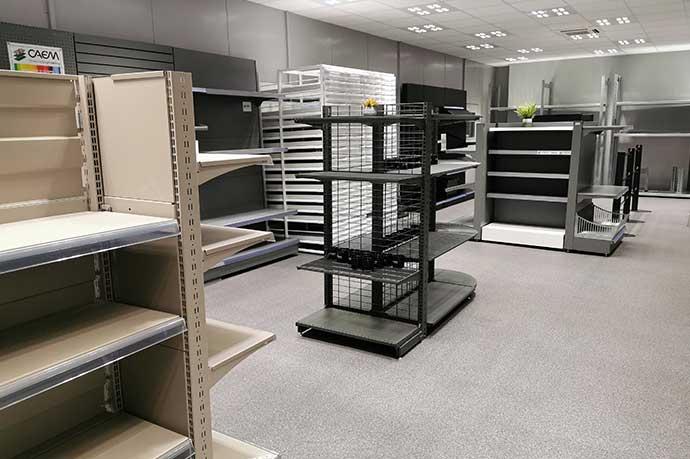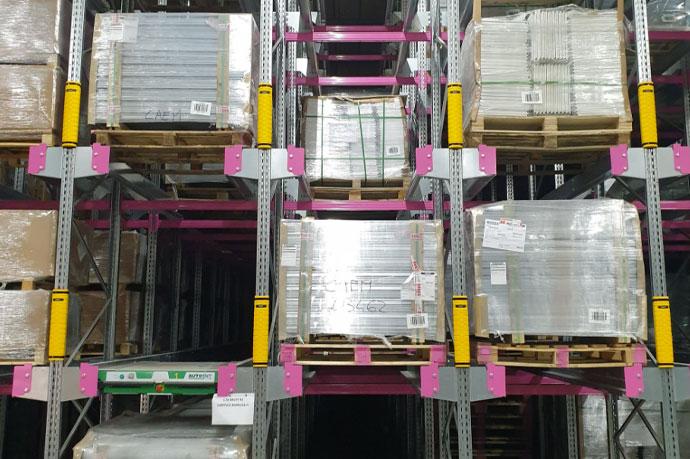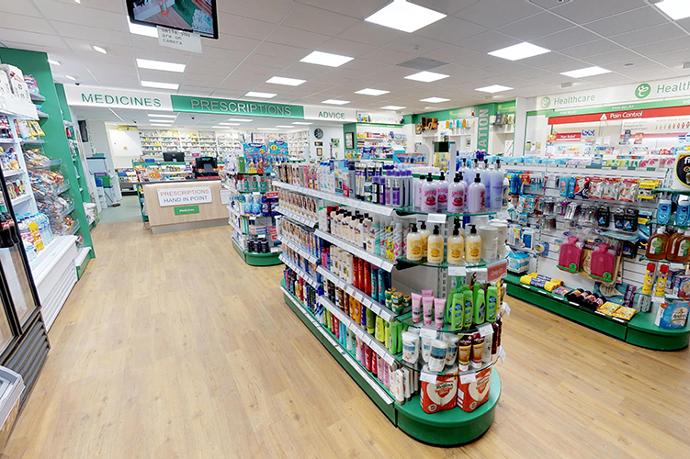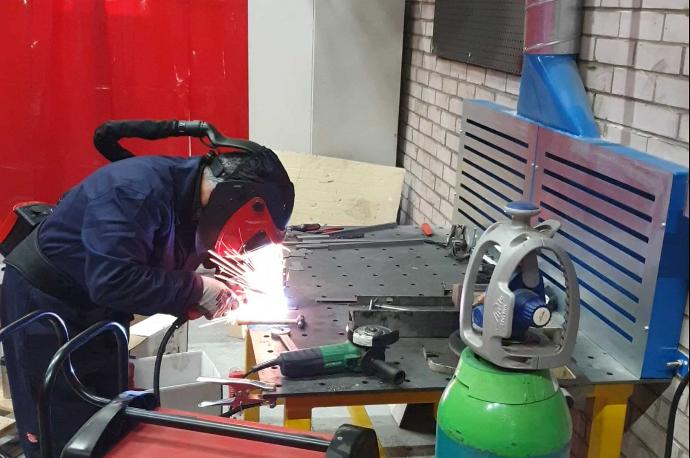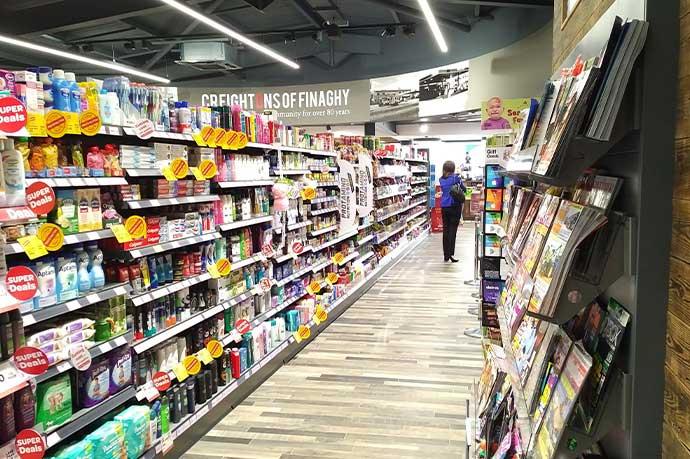https://www.caem.co.uk/if50-shelving-integrated-racking
Integrated Racking for Builders Merchants
In today's competitive builders merchant environment, every square meter represents potential profit. The IF50 integrated racking system stands as a game-changing solution, transforming storage management in these high-demand settings. For an industry where quick access to products directly impacts customer satisfaction and sales, implementing the right racking system isn't merely advantageous—it's fundamental to operational success.
Introduction to Builders Merchants Integrated Racking
Understanding Integrated Racking Systems
Integrated racking systems form the backbone of efficient storage organization for builders merchants. These robust systems handle substantial loads while withstanding the rigors of daily merchant operations. Their configurable nature allows customization based on inventory requirements—whether storing timber, bricks, pipework, or mixed merchandise. This flexibility ensures optimal accessibility, dramatically improving operational workflow.
According to industry research, the global industrial racking system market is projected to grow from £7.5 billion in 2025 to £9.7 billion by 2032, reflecting a 3.9% CAGR. This growth underscores the increasing recognition of efficient storage solutions as critical business investments rather than mere infrastructure expenses.
Importance for Builders Merchants
For builders merchants, strategic racking systems deliver measurable benefits across multiple operational areas. They maximize available space usage while ensuring materials remain readily accessible, significantly boosting staff productivity. Well-organized storage layouts maintain essential safety standards by reducing workplace hazards through proper material segregation and access management.
The retail sector now holds a 41% share of the industrial racking market in 2024, highlighting the growing emphasis on sophisticated storage solutions in customer-facing environments. By improving product visibility and accessibility, these systems facilitate faster customer service—a critical competitive advantage in today's market.
Modern integrated systems incorporate protective elements like rack-mounted roofs and weatherproof curtains, safeguarding inventory from environmental damage. This protection directly impacts profitability by reducing damaged stock and waste, particularly important for moisture-sensitive building materials.
Types of Integrated Racking Systems
Understanding the diverse range of racking options helps builders merchants select systems perfectly matched to their specific storage requirements. Each integrated racking type offers distinct advantages, optimizing space utilization while ensuring safe, efficient material handling.
Pallet Racking
Pallet racking remains the cornerstone of warehouse storage, offering unmatched versatility for palletized goods. Research indicates that 60% of retail warehouses globally implemented selective pallet racking systems in 2022, resulting in notable operational improvements. These systems shine in both interior and exterior settings, with durability-enhancing options including powder-coated or galvanized finishes for weather resistance.
The integration of automated handling equipment with pallet racking has revolutionized stock movement efficiency. Warehouses adopting these technologies report reduced picking times by up to 40%, dramatically improving throughput and customer service capabilities.
Cantilever Racking
Cantilever racking excels in storing long, unwieldy items like timber, pipes, and profiles. Its open-fronted design eliminates obstructive vertical supports, providing unimpeded access to entire stock lengths. This system proves particularly valuable in yard areas where forklifts require generous maneuvering space.
The system's adjustable arms accommodate various product dimensions and weights, making it ideal for builders merchants carrying diverse inventory ranges. Recent innovations include modular cantilever designs that allow for configuration changes as stock requirements evolve, providing future-proof flexibility.
Mezzanine Platforms
Mezzanine platforms maximize vertical space utilization without requiring expensive building modifications. By creating additional elevated storage zones, these structures effectively double usable floor space within the same footprint—an invaluable advantage for merchants in high-rent locations or with limited expansion options.
Beyond storage, mezzanines provide valuable multi-purpose areas that can serve as showrooms, offices, or specialized product display zones. Their integration with vertical storage systems creates comprehensive solutions that transform spatial utilization while maintaining proper stock organization and accessibility.
Shelving Solutions
Shelving solutions offer exceptional flexibility for both retail displays and back-of-house storage. They effectively showcase diverse product types while ensuring visibility and customer accessibility. With adjustable configurations accommodating varying weights and dimensions, these systems perfectly match the dynamic inventory needs typical in builders merchants.
Modern shelving innovations include integration with digital inventory management systems, incorporating features like scan locations and real-time stock tracking. This technology integration enables merchants to maintain accurate inventory records while optimizing shelf space utilization.
Benefits of Integrated Racking for Builders Merchants
Implementing integrated racking systems delivers measurable advantages that directly impact operational performance and customer satisfaction. These benefits extend beyond simple storage to become strategic business assets.
Optimizing Space and Efficiency
Integrated racking dramatically transforms space utilization through vertical storage maximization. The IF50 system's design principles increase storage capacity within existing floorplans, eliminating the need for costly facility expansions. This optimization creates structured inventory organization that reduces search times and improves workflow.
Merchants implementing integrated vertical storage solutions report inventory capacity increases of up to 40% within the same physical footprint. This expansion capability proves particularly valuable in urban locations where space commands premium prices. By consolidating storage vertically, merchants free valuable floor space for additional retail areas or expanded product lines.
Enhancing Stock Accessibility
Properly designed integrated racking systems substantially improve stock accessibility through logical organization principles. The IF50 system ensures frequently accessed items remain within convenient reach while maintaining clear sightlines throughout storage areas. This thoughtful arrangement minimizes handling time while accelerating order fulfillment.
Accessibility improvements directly translate into enhanced customer experience—when staff quickly locate needed materials, wait times decrease and customer satisfaction rises. For contractors operating on tight schedules, this efficiency represents a compelling reason to choose one merchant over competitors.
Improving Safety Standards
Safety remains paramount in any storage environment, particularly when handling heavy building materials. Integrated racking systems incorporate robust safety features that protect both inventory and personnel. The structural integrity of systems like IF50 prevents overloading issues while maintaining stable load distribution.
Recent safety innovations include seismic protection enhancements that prevent collapse during structural disturbances. Additionally, ergonomic pick zone designs reduce strain on staff while improving efficiency. Safety features like anti-collapse mesh and reinforced frames protect both employees and valuable inventory from accidents, creating a more secure working environment.
The IF50 Integrated Racking System: Technical Specifications
The IF50 represents the cutting edge of integrated racking technology, specifically engineered to meet builders merchants' unique demands. Its comprehensive design addresses key industry challenges while providing exceptional versatility.
Key Features and Components
The IF50 system incorporates a modular framework built around the TN9 Profile—a structural component delivering exceptional load-bearing capacity. This profile serves as the system's backbone, with interlocking components allowing customized configurations without sacrificing structural integrity.
Technical specifications include:
- Load capacity: Up to 750kg per shelf level with even weight distribution
- Bay width options: 900mm, 1000mm, and 1200mm standard configurations
- Height options: 1500mm to 3000mm in 250mm increments
- Depth options: 370mm, 470mm, 570mm, and 670mm
- Material composition: High-tensile galvanized steel with powder-coated finish options
- Shelf types: Metal, chipboard, or wire mesh options depending on application
The system's distinguishing feature lies in its integrated approach—rather than separate components assembled on-site, the IF50 arrives as a cohesive system with pre-engineered compatibility between elements. This integration ensures consistent performance while simplifying installation.
Comparative Advantages
When measured against traditional racking solutions, the IF50 system delivers several measurable advantages:
- Installation efficiency: 40% faster installation compared to non-integrated systems
- Adaptability: Reconfiguration without specialized tools or complete disassembly
- Expansion capability: Modular design allows seamless addition of new sections
- Safety factor: 1.5x safety margin exceeding industry standards
- Visual merchandising: Integrated display options enhance retail presentation
These advantages translate into tangible business benefits including reduced downtime during installation, future-proof flexibility, and enhanced customer experience through superior product presentation.
Customizing Racking Solutions for Specific Needs
Builders merchants handle remarkably diverse inventory—from heavy building materials to delicate fixtures. This product variety demands tailored storage approaches rather than one-size-fits-all solutions.
Tailored Solutions for Different Products
The IF50 system's modular architecture enables precise customization based on specific merchandise requirements. When storing heavy bagged products like cement or aggregates, reinforced shelving with appropriate load ratings prevents structural issues. For plumbing supplies, specialized dividers create organized compartments that prevent mixing of similar components.
Customization extends beyond physical structure to include operational considerations. For high-turnover items, configurations prioritize quick access and replenishment efficiency. Seasonal products benefit from modular designs that allow temporary expansion during peak demand periods without permanent space commitment.
Case Studies: Success Stories
CAEM S50 Racking Implementation for UK Builders Merchant
A medium-sized UK builders merchant with diverse inventory faced significant challenges with inefficient product displays and difficulty helping customers locate stock. After implementing CAEM's S50 50mm integrated modular racking and shelving system, the merchant experienced dramatic improvements.
The solution combined metal and wooden shelves optimized for different product categories, with wall shelving and retail displays finished in white with distinctive red accents. This visual coherence improved store navigation while the durable powder-coated finishes ensured longevity in high-traffic areas.
Results included measurably improved product visibility, increased sales conversions from enhanced accessibility, and a more cohesive brand presentation across multiple locations.
Independent Regional Merchant's Flexible Modular Shelving Transformation
An independent merchant operating three large-format stores struggled with inflexible storage that complicated seasonal product rotations and promotional displays. After switching to a flexible modular shelving system combining both shelf and hanging storage options, the operation experienced remarkable efficiency gains.
The new system's tool-free reconfiguration capability and integrated signage compatibility streamlined store refreshes while improving promotional effectiveness. Quantifiable benefits included a 50% reduction in seasonal layout change time and a 15% increase in promotional item sales. Staff also reported fewer workplace accidents due to improved organization and clearer pathways.
Large Builders Merchant Chain's Data-Integrated Racking System
A top-10 UK builders merchant group implemented an innovative racking system with integrated IoT sensors and cloud-based warehouse management software. This technological integration enabled real-time inventory tracking and condition monitoring throughout their distribution centers.
The implementation reduced inventory errors by 60% while accelerating dispatch times for online and click-and-collect orders by 25%. Advanced analytics capabilities also identified slow-moving stock more effectively, resulting in a 35% reduction in obsolete inventory costs through more targeted purchasing.
Implementing a New Racking System
Successfully implementing a new racking system requires methodical planning and execution. This structured approach ensures the solution aligns with operational requirements while minimizing business disruption.
Assessment and Planning
The foundation of any successful racking implementation begins with comprehensive operational assessment. This process analyzes current and projected inventory volumes, identifies frequently accessed items, and determines optimal layout based on workflow patterns.
Systems like integrated rack structures (iRS) prove particularly effective for timber merchants due to their combination of storage efficiency and structural integrity. During planning, consider incorporating protective elements like rack-mounted roofs that reduce weather damage—a feature that consistently delivers measurable reductions in timber waste.
Planning should also incorporate flexibility for future growth. Modular systems that accommodate expansion without complete reconfiguration provide valuable long-term adaptability as business needs evolve.
Installation Process
Professional installation by certified specialists ensures both safety compliance and optimal system performance. For builders merchants, phased implementation often minimizes operational disruption—allowing sections to remain functional during the transition.
Installation should accommodate both immediate requirements and future flexibility. For example, configuring systems with single-sided access near walls while maintaining double-sided access in central areas maximizes space utilization while preserving workflow efficiency.
The installation team should conduct comprehensive testing under full load conditions before handover, verifying system integrity and performance under real-world conditions. This verification process prevents potentially costly issues after full implementation.
Maintenance Best Practices
Maintaining racking systems properly extends operational lifespan while ensuring ongoing safety. Regular inspections should check for structural integrity, load compliance, and damage from handling equipment. These maintenance protocols typically include:
- Weekly visual inspections by trained staff
- Quarterly detailed structural evaluations
- Immediate reporting and addressing of damage
- Load compliance verification during inventory changes
- Annual professional assessment
Staff training represents a crucial maintenance component often overlooked during implementation. Ensuring personnel understand proper loading techniques, weight distribution principles, and damage reporting procedures significantly reduces system wear while extending operational lifespan.
ROI Analysis for Integrated Racking Systems
Understanding the financial impact of racking investments helps merchants make informed decisions aligned with business objectives. A structured ROI analysis considers both direct and indirect benefits when evaluating system performance.
Calculating Cost Benefits
The primary financial benefits of integrated racking systems include:
- Increased storage capacity: Utilizing vertical space can expand inventory capacity by 30-40% without facility expansion
- Reduced handling time: Organized storage typically reduces product location time by 25-30%
- Decreased product damage: Proper storage reduces inventory damage by 15-20% annually
- Labor efficiency: Improved accessibility reduces staff time per order by 10-15%
- Space utilization: Converting storage areas to retail space can increase revenue-generating floor area
When calculating ROI, consider both implementation costs (equipment, installation, training) and ongoing expenses (maintenance, repairs, system updates). Most merchants achieve full ROI within 18-24 months, with continued benefits accruing throughout the system's operational lifespan—typically 10+ years with proper maintenance.
Long-Term Value Assessment
Beyond immediate financial returns, integrated racking delivers significant long-term value through:
- Scalability: Modular systems grow alongside business expansion
- Adaptability: Reconfigurable components adjust to changing inventory profiles
- Customer experience: Organized presentation improves shopping experience
- Staff satisfaction: Improved ergonomics and reduced frustration enhance retention
- Health and safety compliance: Proper storage reduces workplace incidents and associated costs
These factors, while sometimes challenging to quantify precisely, contribute substantially to overall business success and competitive positioning.
Considerations When Choosing a Racking Supplier
Selecting the right supplier significantly impacts project success. Beyond product specifications, several crucial factors distinguish exceptional suppliers from adequate ones.
Evaluating Quality and Durability
Quality assessment should verify compliance with British and European standards, including F.E.M. 10-2-02 and S.E.M.A design codes. These standards ensure systems meet rigorous safety and performance requirements.
Evaluate supplier history and experience—particularly their track record with similar builders merchant installations. Experienced suppliers understand sector-specific challenges like accommodating irregular product dimensions, managing outdoor storage requirements, and integrating retail and storage functions.
Material certification verification provides assurance of component quality and consistency. Request documentation confirming appropriate load testing and material composition—particularly important for systems exposed to challenging conditions.
Effectiveness and ROI Analysis
Request data-backed performance metrics from potential suppliers, including case studies demonstrating measurable improvements in comparable installations. Comprehensive ROI analysis should include:
- Initial investment costs (equipment, installation, training)
- Operational improvements (space utilization, handling efficiency)
- Maintenance requirements and associated expenses
- System lifespan and depreciation considerations
- Potential future expansion costs
This analysis provides a clear picture of total ownership cost rather than focusing solely on initial purchase price—often revealing that higher-quality systems deliver superior long-term value despite higher upfront investment.
Customer Support and Services
Comprehensive support encompasses pre-installation design consultation, professional installation, and ongoing service. Evaluate supplier responsiveness during the quotation process as an indicator of future service quality.
Look for suppliers offering modular solutions with scalability options that accommodate phased development. This approach allows implementation aligned with budget cycles while ensuring system coherence throughout expansion.
Post-installation support availability proves particularly important when operational needs change or issues arise. Suppliers offering rapid response maintenance and access to replacement components minimize potential downtime.
Frequently Asked Questions
What is the typical implementation timeframe for an integrated racking system?
Implementation timing varies based on project scope, but typically follows this timeline:
- Initial assessment and design: 1-2 weeks
- Manufacturing and delivery: 3-5 weeks
- Installation: 1-3 weeks depending on system size
- Testing and handover: 1 week
Most merchant implementations complete within 6-10 weeks from initial consultation to operational handover. Phased implementations allow continuous operation throughout the transition process.
What space requirements should we consider before installation?
Besides the obvious footprint requirements, consider these spatial factors:
- Ceiling height clearance (including lighting and sprinkler systems)
- Aisle width for handling equipment maneuvering
- Access points for loading/unloading
- Floor load capacity for heavy storage systems
- Expansion space for future growth
A professional supplier conducts thorough site surveys to identify potential constraints before finalization of system design.
What ongoing maintenance do integrated racking systems require?
Effective maintenance programs typically include:
- Weekly visual inspections by trained staff
- Quarterly structural checks
- Annual professional assessment
- Immediate repair of identified damage
- Load testing after significant changes
Most systems require minimal maintenance when properly installed and operated, with annual professional inspections representing the most significant ongoing requirement.
How can we maximize ROI from our racking investment?
Maximizing return involves several strategic approaches:
- Train staff thoroughly on proper system utilization
- Optimize product placement based on access frequency
- Implement complementary inventory management systems
- Regularly reassess space utilization as inventory changes
- Consider seasonal adjustments for merchandise focus areas
Combining physical racking optimization with efficient operational processes delivers superior financial performance compared to focusing solely on storage hardware.
Conclusion: Maximizing Potential with Integrated Racking Systems
Integrated racking systems fundamentally transform how builders merchants manage inventory and serve customers. The IF50 integrated racking system exemplifies how modern storage solutions deliver operational advantages while accommodating future growth.
Recap of Key Points
Throughout this exploration, we've seen that effective racking systems do far more than simply store products—they optimize space utilization, enhance accessibility, improve safety standards, and boost operational efficiency. Systems like the IF50, with their modular and robust design principles, enable merchants to create tailored solutions that address specific business requirements.
The implementation of integrated racking delivers measurable benefits including increased storage capacity, reduced handling time, enhanced inventory protection, and improved customer service. These advantages translate directly into improved profitability and competitive positioning.
Future Trends in Builders Merchants Storage Solutions
Looking forward, several emerging trends will shape storage solutions for builders merchants:
- Sustainability focus: Eco-friendly materials and designs increasingly prioritized, with recycled materials supporting greener operations without compromising structural integrity
- Technology integration: IoT sensors enabling real-time inventory tracking and management, with early adopters reporting significant efficiency improvements
- Vertical optimization: Advanced vertical storage solutions maximizing previously unused overhead space without expanding facility footprints
- Urban adaptation: Narrow aisle configurations and compact storage enabling merchants to maintain comprehensive inventory despite space constraints
- Customization emphasis: Highly adjustable systems precisely tailored to specific product ranges and operational workflows
These developments reflect the industry's evolution toward more efficient, sustainable, and technologically integrated storage solutions. By embracing these innovations, builders merchants position themselves for continued success in an increasingly competitive marketplace.
